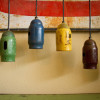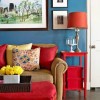There’s a funny thing about being an interior designer. When I meet someone new at a party and tell them what I do for a living, their eyes light up. The descriptions start to flow (“So, in the corner of my kitchen, I have this weird thing where…”). Then the air drawing begins (“Over here it goes like this, and then turns the corner and…”). And finally, with a little reminder that we possess an incredible tool for visual communication in our pockets, the dark and blurry phone pictures come out. After enough gesticulation to make Italian grandparents very proud, this person usually turns to me and asks, “What should I do?!”.
It’s at this point I’m often reminded of a dermatologist friend who gently advises new acquaintances that while she’s happy to look at their suspicious mole in dim light with a cocktail in hand, it doesn’t pass for a diagnosis.
 Just like a doctor gains critical information using a microscope, a designer uses visual cues to assess the impact of what you may think is insignificant. We can take what seems small and make it grand in importance (“Your fluorescent overhead lights make this space feel like an operating room, which is why you don’t want to spend time in here.”), and we can turn what feels like an overwhelming prospect (“Our house is too small and we have to move!”), into a manageable project (“Your furniture is too big for the size of the room, and you need more efficient storage.”).
Just like a doctor gains critical information using a microscope, a designer uses visual cues to assess the impact of what you may think is insignificant. We can take what seems small and make it grand in importance (“Your fluorescent overhead lights make this space feel like an operating room, which is why you don’t want to spend time in here.”), and we can turn what feels like an overwhelming prospect (“Our house is too small and we have to move!”), into a manageable project (“Your furniture is too big for the size of the room, and you need more efficient storage.”).
While nothing quite substitutes for having a designer into your home, there are plenty of changes you can make yourself that will have a big impact, without breaking the bank.
- Get organized.
Frequently on an initial appointment, a client will tell me they need more space, more storage, more something. Many times, my response is that I feel they actually need less. I give them homework of de-cluttering, after which we can re-assess their needs for that particular area. Sometimes this approach can save people money, if it turns out their current storage is sufficient once they’ve donated long-forgotten clothing and recycled all those old college essays! For more great organizing tips, check out my colleague’s blog here. - Repurpose. Revamp.
The list of “re-” can go on and on! Have an old tripod you never use? Have it wired by a local shop into a lamp. A table you like that’s seen better days? Refinish it! An heirloom sofa from your Great Aunt Ida that’s in perfect condition, but doesn’t suit your taste? Reupholster! Pinterest is an amazing resource for DIY project ideas. - Lighten up!
Time and again, I’ll go to a friend’s house for dinner, and we sit down to a gorgeous meal under a single, glaring, overhead light. I’ve been known to covertly borrow bedside table lamps and set them up in the dining room while the host is still cooking! The powerful psychological and emotional impact of lighting cannot be underestimated. Think about how good you feel in the fading, early evening light of late summer, or how pretty candlelight makes you look.
Clean your light fixtures. Dust and dead bugs accumulate quickly and can dramatically decrease a fixture’s illumination.
Change your lightbulbs. I like these warm, dimmable LED alternatives to an incandescent 60W. Not only are they super energy efficient, they have a pleasant, natural color temperature.
Put everything on a dimmer. Yes, everything. Even the bathroom. Try these from Lutron. They are easy to install with just a screwdriver.
- Paint.
It’s the cheapest and easiest way to make a huge change! What colors make you happy? For cues, go to your closet and pull out what you wear and love the most. Look around at your art and your favorite things. Go outside. Thumb through National Geographic. Color inspiration is everywhere!
- Decorate with fabric.
A beautiful textile can cover up a multitude of sins, and is one of the most affordable and easiest art objects to bring home from travels abroad. Etsy and Ebay have great deals, too. Don’t be bound by the description on the tag. Fabric is fabric.A handwoven Mexican tablecloth folded in half can offer fantastic color, pattern and texture to the end of a bed or the back of a shabby sofa. A table runner can serve as a wall hanging in an awkwardly narrow space. Embroidered or hand-painted napkins can be laid on the diagonal over a dresser, creating a perfect spot to rest delicate jewelry while protecting the wood.
The design conversations frequently conclude with the person I’ve met saying my job sounds like fun. It is! I’m deeply grateful to love what I do. Grateful that it excites and inspires people. And grateful that I know good design isn’t just about making things look pretty (though, of course, that doesn’t hurt), but about having a sometimes profound impact on a client’s well-being, from health and happiness to rest and productivity. Make a few changes in your home, and see what happens!
Rachelle Padgett is on Houzz, Facebook, LinkedIn, Pinterest, Instagram, and Yelp.







